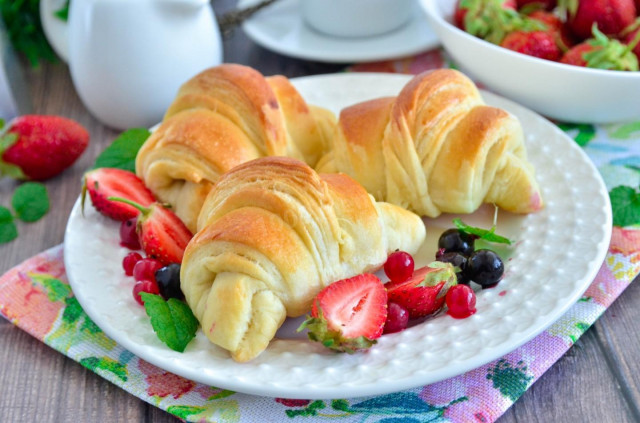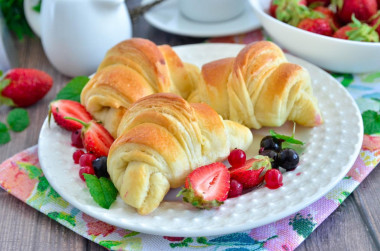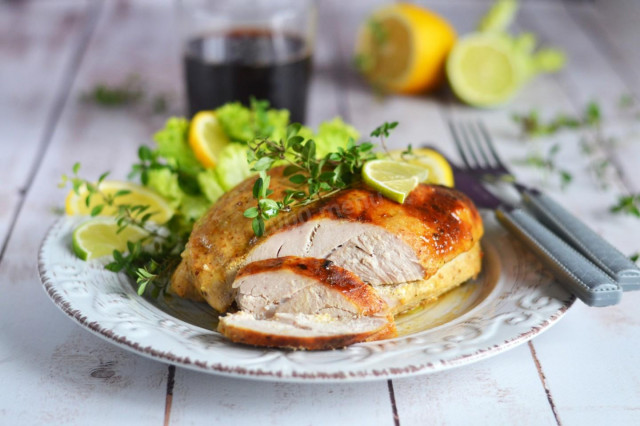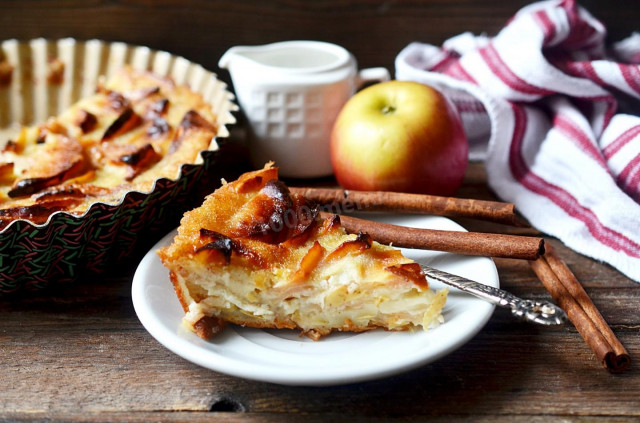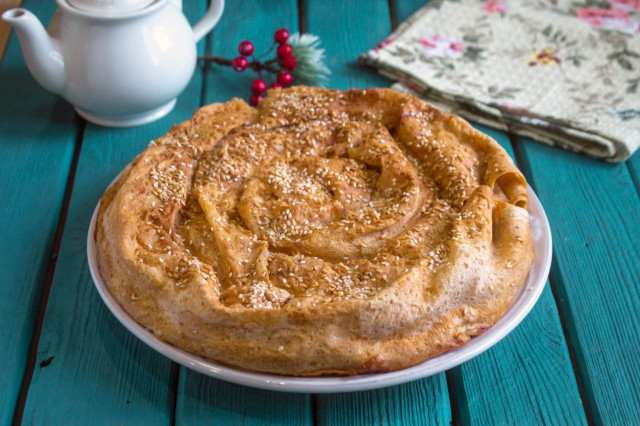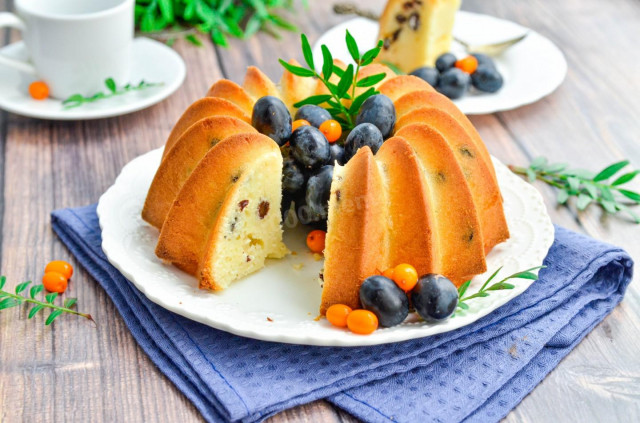Composition / ingredients
Step-by-step cooking
Step 1:
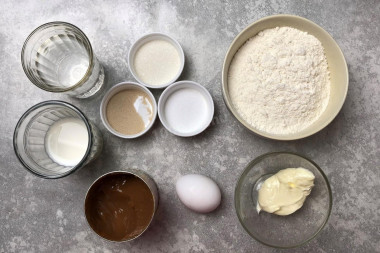
How to make croissants from homemade puff pastry? Prepare the products. Choose butter of the best quality, corresponding to GOST. Take it out of the refrigerator in advance so that it becomes soft. Jam, thick jam, chocolate, boiled condensed milk are well suited as a filling. I just have condensed milk.
Step 2:

Take a large bowl, pour hot water (not boiling water) and cold milk into it. Touch the liquid with your finger, it should become pleasantly warm. If the mixture is still hot, then wait a little while until it cools down. If cold, add some hot water. This is all done so that the yeast, which will dissolve in the liquid, will be activated, and not die or wake up. Read more about yeast at the link at the end of the recipe.
Step 3:
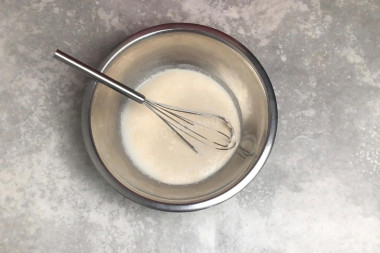
Pour yeast and sugar into a bowl, mix. Cover the bowl with a towel and leave for 15 minutes. During this time, the yeast will become active and rise above the surface of the cap. If that didn't happen, you'll have to take others.
Step 4:
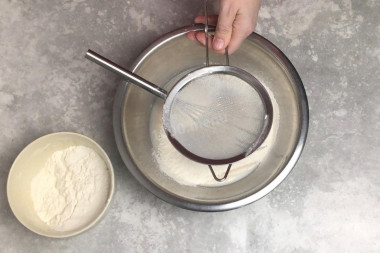
Sift a third of the flour into a bowl. Stir with a whisk. Then another third, add salt with it. Mix the dough again. Add the last third in parts. The whisk will already interfere hard, take a spoon. And then knead with your hands.
Step 5:
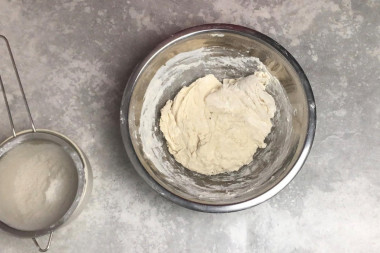
The dough should become quite thick, adjust its consistency with flour. It may not be all gone, like mine, or you will have to add more. Put 30 grams of soft butter in the dough. Get him involved. And finally knead the dough. It will be very sticky at first, but gradually it will begin to move away from the walls. It will take a long time to knead, 7-10 minutes.
Step 6:
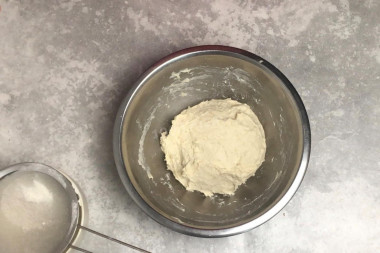
When this happens, assemble the dough into a ball. Cover the bowl with a towel and put it in a warm place to rise for 1.5-2 hours. I always put the dough in the cold oven turned off.
Step 7:

During this time, the dough will double in volume. Remember him. The dough is very soft, pliable and absolutely not sticky.
Step 8:
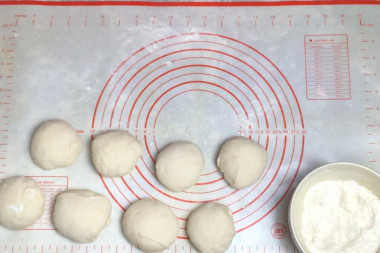
Divide the dough into 8-10 equal parts, roll each into a ball.
Step 9:

Roll each ball into a thin circle.
Step 10:

When all the balls are rolled out, start forming puff pastry. Take one circle and spread a little butter on it. The layer should be very thin and uniform. I smeared with a teaspoon, you can do it with a brush. Cover the greased cake with a second one, lubricate it in a similar way. And so all the cakes.
Step 11:
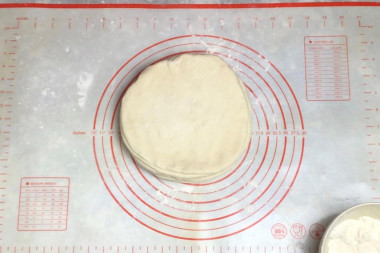
The last, upper one, does not need to be lubricated. You will get such a stack of greased tortillas.
Step 12:
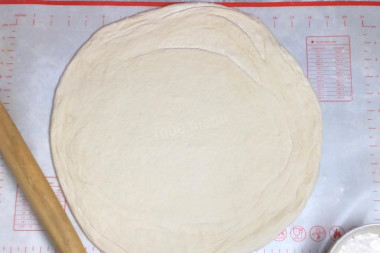
Take a rolling pin and roll out the resulting blank into a thin layer. The thinner, the better. I didn't have enough table size to make the layer very thin, and the croissants eventually came out small and plump, which did not affect their taste in any way. To prevent the dough from sticking to the table or rolling pin, sprinkle them with flour. When rolling out, you can turn the layer on different sides.
Step 13:
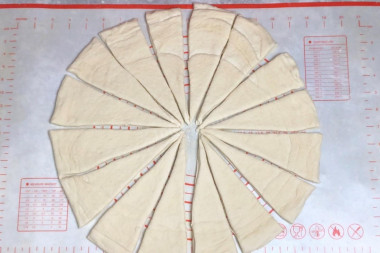
Cut the resulting circle into 16 segments.
Step 14:

Shape the croissants. Make an incision at the base, put the filling.
Step 15:
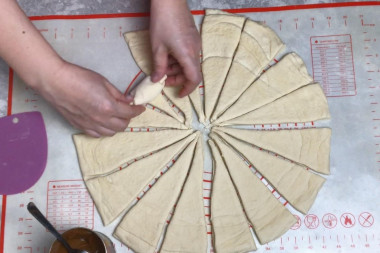
And twist to the center with a roll.
Step 16:
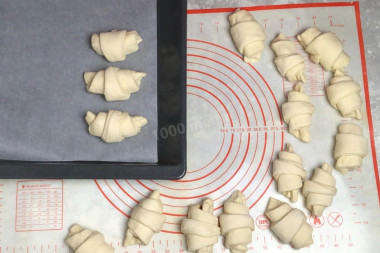
Cover the baking sheet with baking paper. Place the croissants on it, bending them slightly in the shape of a crescent.
Step 17:
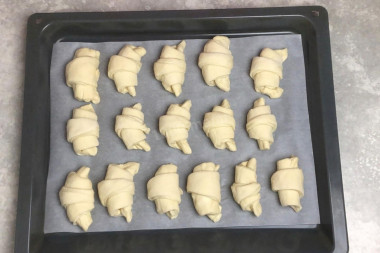
Put the croissants at a distance from each other, as they will grow in size when baking.
Step 18:

Shake the egg yolk with a tablespoon of milk. Brush the croissants with this mixture on top. It is convenient to do this with a culinary brush.
Step 19:

Preheat the oven to 210°C. Put the croissants in it, bake for 10 minutes, then reduce the temperature to 190 ° C and bake them for another 15-20 minutes until golden brown. The baking time may vary, depending on your oven. Focus on the appearance of croissants.
Step 20:

Remove the finished croissants and cool. Serve with coffee, tea or milk.
Important! Using dry yeast, it should be borne in mind that they occur in two forms: active and instant (read the instructions carefully before use!).
Active dry yeast looks like beads or small balls. Before applying them, they must be brought out of "sleep mode". To do this, the active yeast is diluted in warm sweet water, milk or whey. The resulting bubbles, foam or "cap" indicate that the yeast is ready for further use. Active dry yeast must be brought to complete dissolution in the liquid, otherwise, due to the remaining grains, the dough may not rise and the baking will be spoiled (yeast grains that have not dissolved in the liquid and got into the dough will not disperse on their own, which means they will not work).
Instant dry yeast is easier to use. They do not need to be activated before use. Such yeast, along with other ingredients, is simply added to the dough. As a result, the baking time is reduced.
It should also be remembered that both types of dry yeast may differ in their activity from different manufacturers.
It is important to sift the flour to saturate it with oxygen. Then the baking will turn out to be airy and will rise well when baking.
Choose high-quality, proven condensed milk. Without vegetable fats and food additives. The composition should contain only two ingredients: milk and sugar. As a result, the taste and quality of the finished dish will depend on the quality of condensed milk.
Caloric content of the products possible in the composition of the dish
- Whole cow's milk - 68 kcal/100g
- Milk 3.5% fat content - 64 kcal/100g
- Milk 3.2% fat content - 60 kcal/100g
- Milk 1.5% fat content - 47 kcal/100g
- Concentrated milk 7.5% fat content - 140 kcal/100g
- Milk 2.5% fat content - 54 kcal/100g
- Whole durum wheat flour fortified - 333 kcal/100g
- Whole durum wheat flour, universal - 364 kcal/100g
- Flour krupchatka - 348 kcal/100g
- Flour - 325 kcal/100g
- Granulated sugar - 398 kcal/100g
- Sugar - 398 kcal/100g
- Butter 82% - 734 kcal/100g
- Amateur unsalted butter - 709 kcal/100g
- Unsalted peasant butter - 661 kcal/100g
- Peasant salted butter - 652 kcal/100g
- Melted butter - 869 kcal/100g
- Salt - 0 kcal/100g
- Water - 0 kcal/100g
- Egg yolks - 352 kcal/100g
- Boiled condensed milk - 328 kcal/100g
- Dry yeast - 410 kcal/100g

